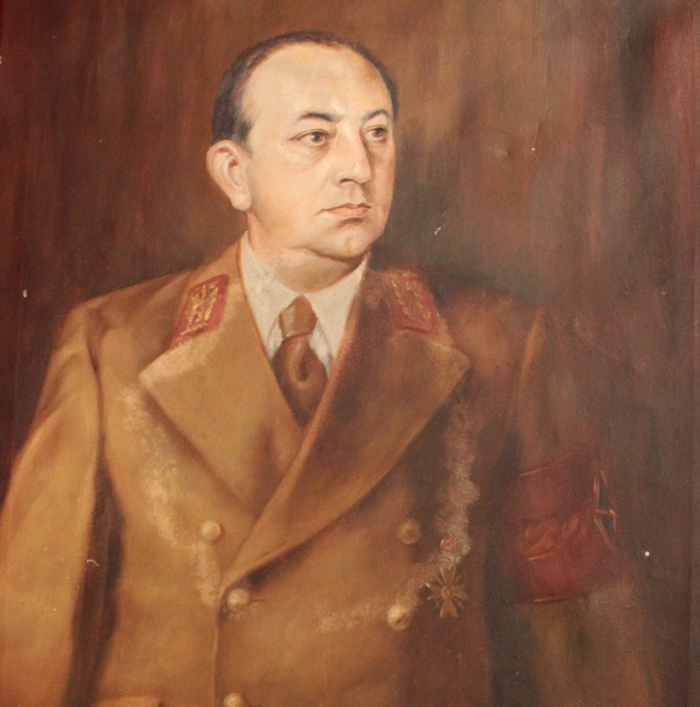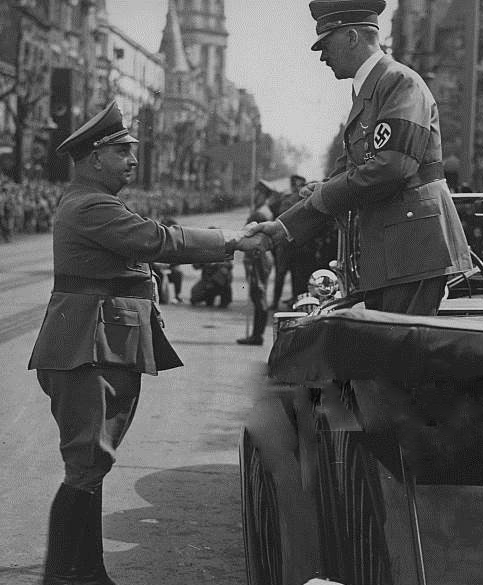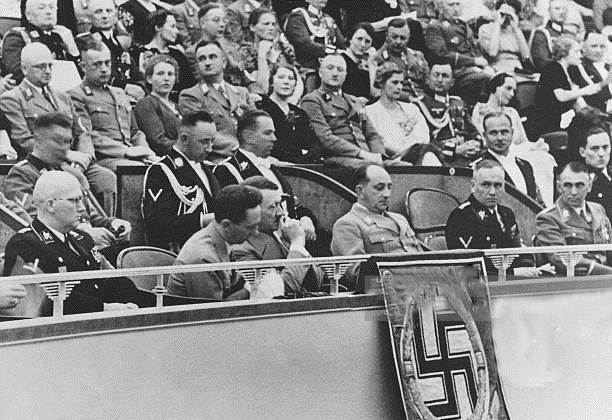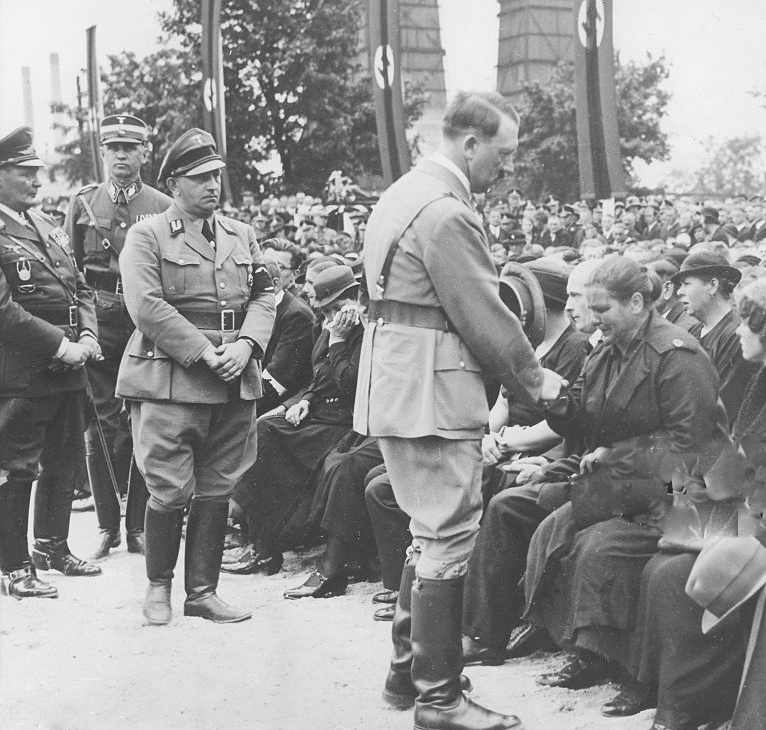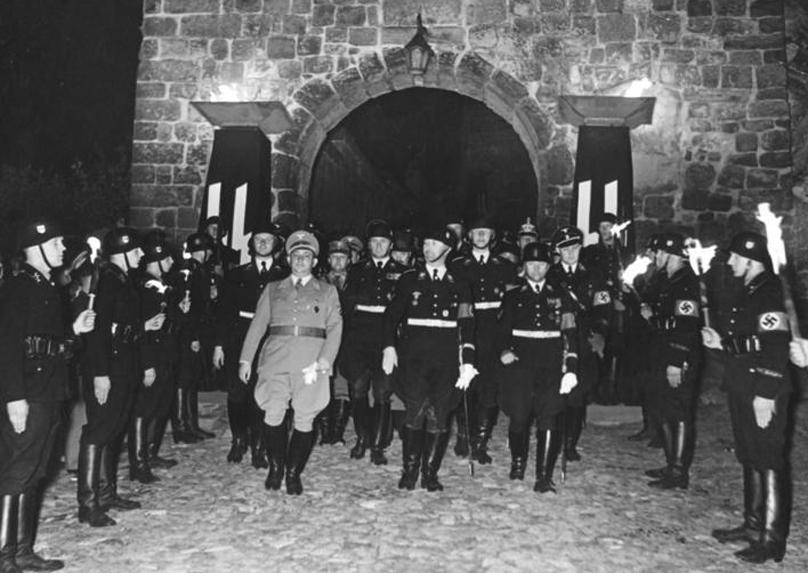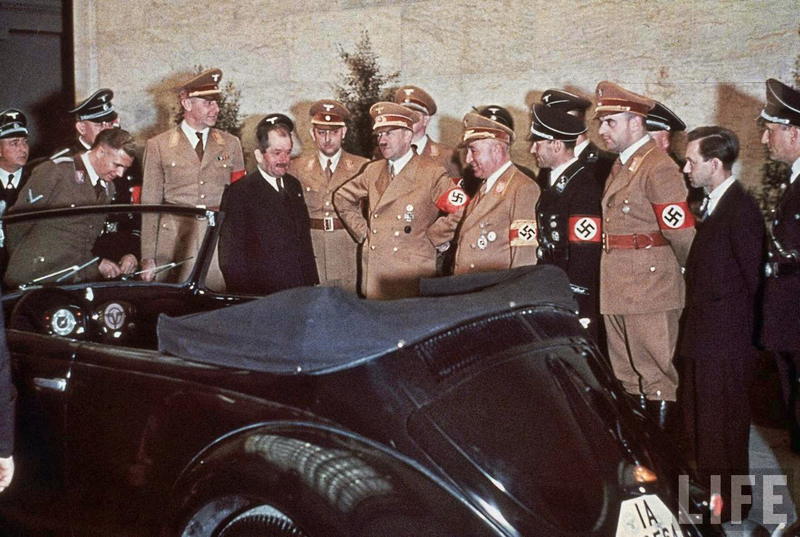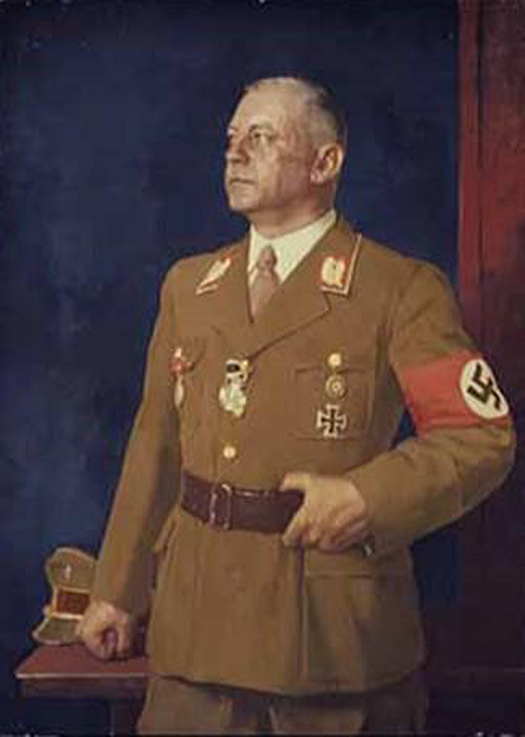Original 1930’s Third Reich Portrait of Rudolf Jordan Hitler's Personally Appointed Gauleiter of Halle-Merseburg & Magdeburg-Anhalt and Former General of the SA, Gruppenfuhrer der SA. Likely Commissioned & Paid For By Adolf Hitler Personally
Most rare surviving example of the official portrait of one of Hitler’s personally appointed district political leaders known as a Gauleiter, as almost all of around 450 original, 1930’s German portraits of Hitler’s inner circle and high command are now in the U.S. Army Center of Military History in Washington. Each portrait could have cost up to 12,000 Reichmarks each, a most considerable sum in 1939 around 60,000 dollars
Hitler usually bought and paid for them all personally, and the small Zinc bust of Rudolf Jordan by Albert Gottlieb he bought and paid 2000 Reich Marks for it in 1941 {about $10,000 US at the time} it's in the Deutsches Historisches Museum.
Approximately 114 men held the highly esteemed position of Gauleiter. Many shared a common background. Most of them, particularly during the early years, were drawn from the cadre of "old fighters" that had helped Hitler forge the Party during the Kampfzeit (Time of Struggle). The rank and power of these men was shared equally and was only four below Hitler himself. Their power was thus highly significant within the echelons of the Third Reich.
Many of these portraits were either commissioned, or acquired by Hitler personally, and they are all part of the record of Hitler and his elite commanders rise to power, in order to satisfy his determination to conquer the world and subjugate and destroy all who resisted.
No dictator can effectively govern a nation on his own. This was certainly the case with Adolf Hitler who had little time for or interest in the day-to-day regional administration of the Nazi Party.
For that purpose, he appointed his most loyal, charismatic and brutal subordinates: the ‘Little Hitlers’, officially known as Gauleiters.
Firstly, after the NSDAP gained power over Germany the Nazi Party adopted a new framework, which divided Germany into regions called Gaue. Each Gaue had its own leader, a Gauleiter. Each Gaue was then divided into subsections, called Kreise. Each Kreise then had its own leader, called a Kreisleiter. Each Kreise was then divided into even smaller sections, each with its own leader, and so on. Each of these sections were responsible to the section above them, with Hitler at the very top of the party with ultimate authority.
As almost all these oil portraits of Germany’s ‘Little Hitler’s’ were removed from Germany in 1945/6 and transported to America, it is estimated that just a very few, perhaps as few as between five or ten remained in Europe and in private hands. This is one of those tiny few. An incredibly rare example of the original, historical, visual record of the power structure organised by Hitler himself. Which makes this an incredibly rare original artifact that is an historically important representation of likely the most important and radical political events of the past thousand years. From those three decades of the 20th century that has changed the very structure of the world for all time.
The US high command in 1945/6 realised just how important it was to keep and save as many such portraits of his gauleiters as possible, as a permanent record and reminder for the future, of the monumental fight and sacrifices in order to subdue the axis powers from their schemes of world domination, during the two most significant decades of the past 300 years..
This is original portrait, in oil on canvas, of Gauleiter Rudolf Jordan (21 June 1902 - 27 October 1988). He was a Nazi Gauleiter in Halle-Merseburg and Magdeburg-Anhalt during Hitler’s socialist Third Reich. One of the notorious and prominent high command of Hitler’s Third Reich. An original Nazi oil portrait from the 1930's. Most similar in the new Aryan style of the Nazi portrait painter Fritz Erler, and his painting of 'Minister and Gauleiter Adolf Wagner', 1936. It was exhibited in the GDK, the Great German Art Exhibition, in 1939, in room 23. It was bought there by Hitler for 12.000 RM. In fact he bought two paintings by Fritz Erler: Portrait des Staatsministers und Gauleiters Adolf Wagner and Portrait des Reichsministers Fricke.
They are now in the possession of the US Army Military Center of History. Possibly this portrait was also in that exhibition with the two other Gauleiter Wagner and Frick. Erlers similar style portrait of Hitler, also painted in his SA uniform, in 1931, is currently valued for sale at 725,000 Euros. Around 450 portraits depicting Hitler and other Nazi-officials and symbols are currently stored in the U.S. Army Center of Military History in Washington
From 19 January 1931, Jordan was appointed Nazi Gauleiter of Halle-Merseburg, and then began rising within the Party ranks, acting as member of the Prussian Landtag between April 1932 and October 1933 and being appointed to the Prussian State Council and made an SA Gruppenfuhrer. In the same year began the publication of the Mitteldeutsche Tageszeitung newspaper, led by Jordan. In March 1933 came his appointment as Plenipotentiary for the Province of Saxony in the Reichsrat and in November 1933 his election as a member of the Reichstag. On 20 April 1937, Adolf Hitler personally appointed him Reichsstatthalter (Reich Governor) in Braunschweig and Anhalt and NSDAP Gauleiter of Magdeburg-Anhalt. Jordan was succeeded as Gauleiter of Halle-Merseburg by Joachim Albrecht Eggeling.
In the same year came Jordan's promotion to SA-Obergruppenfuhrer. In 1939, Jordan became Chief of the Anhalt Provincial Government and Reichsverteidigungskommissar (Reich Defence Commissar, or RVK) in Defence District XI. On 18 April 1944 came Jordan's last leap up the career ladder when he was appointed High President (Oberpresident) of the Province of MagdeburgIn the war's dying days, Jordan managed to go underground with his family under a false name. He was nonetheless arrested by the British on 30 May 1945, and in July of the next year, the Western Allies handed him over to the Soviets. Late in 1950 after four years in custody in the Soviet occupation zone Jordan was sentenced to 25 years in a labour camp in the Soviet Union. Only Federal Chancellor Konrad Adenauer's visit to Moscow managed to persuade the Soviets to reconsider Jordan's sentence, and then he was released on 13 October 1955. In the years to come, Jordan earned a living as a sales representative, and worked as an administrator for an aircraft manufacturing firm. He died in Munich. The Gardelegen massacre was the cold-blooded murder of inmates that had been evacuated from the Dora-Mittelbau concentration camp and some of its sub-camps on April 3rd, 4th and 5th. Around 4,000 prisoners had been bound for the Bergen-Belsen, Sachsenhausen or Neuengamme concentration camps, but when the railroad tracks were bombed by American planes, they had been re-routed to Gardelegen, which was the site of a Cavalry Training School and a Parachutist Training School. The trains were forced to stop before reaching the town of Gardelegen and some of the escaped prisoners had terrorized the nearby villages, raping, looting and killing civilians.
The man who is considered to be the main instigator of the Gardelegen massacre is 34-year-old Gerhard Thiele , who was the Nazi party district leader of Gardelegen. On April 6, 1945, Thiele called a meeting of his staff and other officials at which he issued an order, which had been given to him a few days before by Gauleiter Rudolf Jordan , that any prisoners who were caught looting or who tried to escape should be shot on the spot. In 1932, Nazi Gauleiter Rudolf Jordan claimed that SS Security Chief Reinhard Heydrich was not a pure "Aryan". Within the Nazi organisation such innuendo could be damning, even for the head of the Reich's counterintelligence service. Gregor Strasser passed the allegations on to Achim Gercke who investigated Heydrich's genealogy. Gercke reported that Heydrich was "... of German origin and free from any coloured and Jewish blood". He insisted that the rumours were baseless. Even with this report, Heydrich privately engaged SD member Ernst Hoffman to further investigate and deny the rumours. The last two pictures in the gallery of Jordan with Hitler and his Gaulieters at his 50th birthday examining his convertible Volkwagen Beetle, and the Erler painting of Gauleiter Wagner, bought by Hitler. 2 foot x 3 foot unframed. Water stain at the rear of the canvas. Surviving original portraits of Third Reich leaders are now very rare for at the end of the war thousands of paintings, portraits of Nazi-leaders, paintings containing a swastika or depicting military/war sceneries were destroyed. With knives, fires and hammers, they smashed countless sculptures and burned thousands of paintings. However around 8,722 artworks were shipped to military deposits in the U.S. From 1933 to 1949 Germany experienced two massive art purges. Both the National Socialist government and OMGUS (the U.S. Military Government in Germany) were highly concerned with controlling what people saw and how they saw it. The Nazis eliminated what they called Degenerate art, erasing the pictorial traces of turmoil and heterogeneity that they associated with modern art. The Western Allies in turn eradicated Nazi art. Whatever one considers about the actions of all of the entire third reich, art is art, and every piece is a representation of a portion of history, good or bad. One thing we learned very well from the tragic 1930s and 1940s is that classifying art as non-art and forbidding books or art for political reasons is a dead-end street. No matter how much one dislikes or despises the infamous despots and dictators of history, such as Hitler, Caligula, Pol Pot & Stalin, and no matter how much their depictions were used as propaganda, a painting or sculpture of them cannot be re-classified as 'non art'. This painting depicts a member of Hitler’s notorious inner circle, that for a brief period of world history very nearly placed the entire world in subjugation to the will of Germany and it’s ally Japan. It is the embodiment of why the preservation of such art can remind the thousands of its observers, for generations to come, that those people such as Rudolf Jordan, who were just ordinary looking nondescript individuals, that if left unchecked would have condemned the entire world to a nightmarish dystopia, of slavery, starvation and misery. And thanks to great leaders such as Winston Churchill, who had the talent and skill to embolden a solitary nation, racked by trepidation, facing the free world’s greatest foe alone, they were utterly routed and deposed by the near defeated and subdued great democracies. Part of the theory of Hannah Ahrend Johanna "Hannah" Arendt, 14 October 1906 - 4 December 1975 was a German-born Jewish American political theorist. Though often described as a philosopher, she rejected that label on the grounds that philosophy is concerned with "man in the singular" and instead described herself as a political theorist because her work centres on the fact that "men, not Man, live on the earth and inhabit the world." This portrait would nicely improve with some cosmetic restoration and cleaning.
Code: 20504
4950.00 GBP


